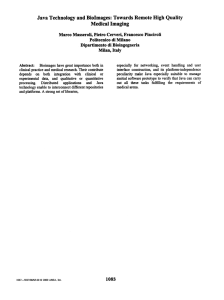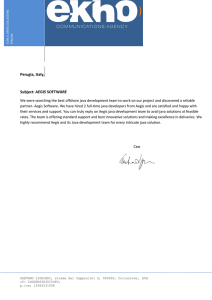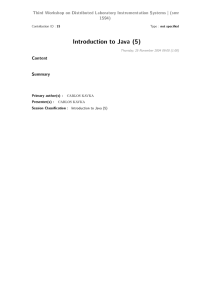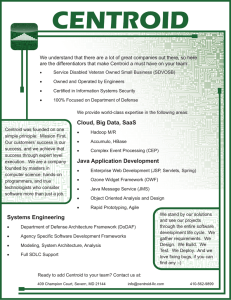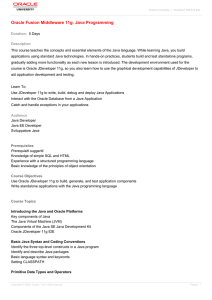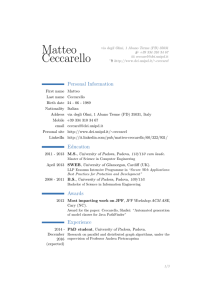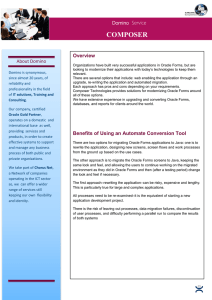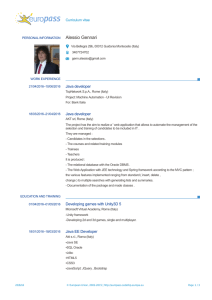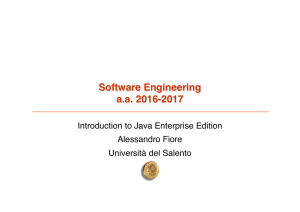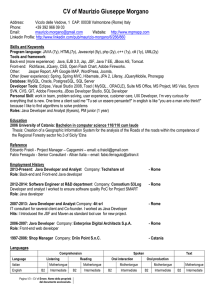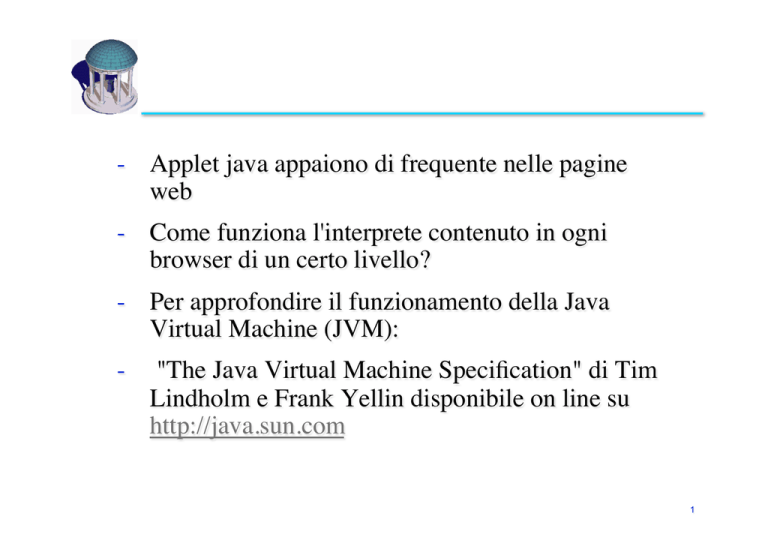
- Applet java appaiono di frequente nelle pagine
web
- Come funziona l'interprete contenuto in ogni
browser di un certo livello?
- Per approfondire il funzionamento della Java
Virtual Machine (JVM): -
"The Java Virtual Machine Specification" di Tim
Lindholm e Frank Yellin disponibile on line su
http://java.sun.com
1
Funzionamento di Java
• A differenza degli altri linguaggi di programmazione
per Java lo scopo fondamentale e' funzionare su ogni
tipo di hadware che possegga un’implementazione
della Java Virtual Machine (JVM). • Il .class che otteniamo dalla compilazione non e'
codificato per il linguaggio macchina • Ad eseguire il .class non sara', quindi, il processore
ma un programma che interpreta i bytecode e
trasmette i comandi corrispondenti al processore.
2
The Java Virtual Machine
Java Architecture • Java Programming Language
• Java Virtual Machine (JVM)
• Java API
3
Reference
The content of this lecture is based on Inside the
Java 2 Virtual Machine by Bill Venners
– Chapter 1 Introduction to Java's Architecture
» http://www.artima.com/insidejvm/ed2/introarchP.html
– Chapter 5 The Java Virtual Machine
» http://www.artima.com/insidejvm/ed2/jvmP.html
– Interactive Illustrations
» http://www.artima.com/insidejvm/applets/index.html
4
The Java Programming Environment
5
The Java Platform
The byte code generated by the Java front-end
is an intermediate form
• Compact
• Platform-independent
6
The Class File
Java class file contains
• Byte code for data and methods (intermediate form,
platform independent)
• Symbolic references from one class file to another
– Class names in text strings
– Decompiling/reverse engineering quite easy
• Field names and descriptors (type info)
• Method names and descriptors (num args, arg types)
• Symbolic refs to other class methods/fields, own
methods/fields
7
Bytecode Basics
• Bytecodes are the machine language of the Java
virtual machine.
• A method's bytecode stream is a sequence of
instructions for the Java virtual machine. Each
instruction consists of a one-byte opcode followed by
zero or more operands. The opcode indicates the
action to take.
• Each type of opcode has a mnemonic. In the typical
assembly language style, streams of Java bytecodes
can be represented by their mnemonics followed by
any operand values.
8
Bytecode Basics ctd.
// Bytecode stream: 03 3b 84 00 01 1a 05 68 3b a7 ff f9
// Disassembly:
iconst_0
// 03
istore_0
// 3b
iinc 0, 1
// 84 00 01
iload_0
// 1a
iconst_2
// 05 ...
9
The Role of the Virtual Machine
Local or
Remote
10
Class Loaders
• Bootstrap (default) loader (in the JVM)
• User-defined (custom) loaders
11
Dynamic Class Loading
• You don't have to know at compile-time all the
classes that may ultimately take part in a running
Java application. User-defined class loaders enable you to
dynamically extend a Java app at run-time
• As it runs, your app can determine what extra
classes it needs and load them • Custom loaders can download classes across a
network (applets), get them out of some kind of
database, or even calculate them on the fly. 12
The Execution Engine
Back-end transformation and execution
• Simple JVM
– byte code interpretation
• Just-in-time compiler
– Method byte codes are compiled into machine code the first time they
are invoked
– The machine code is cached for subsequent invocation
– It requires more memory
• Adaptive optimization
– The interpreter monitors the activity of the program, compiling the
heavily used part of the program into machine code
– It is much faster than simple interpretation, a little more memory
– The memory requirement is only slightly larger due to the 20%/80%
rule of program execution (In general, 20% of the code is responsible
for 80% of the execution)
13
The Java Virtual Machine
14
Shared Data Areas
Each JVM has one of each:
Method area: byte code and class (static) data
storage
Heap: object storage
15
Thread Data Areas
Frame in
Execution
16
Stack Frames
Stack frames have three parts
• Local variables
• Operand stack
• Frame data
17
Stack Frame
Local Variables
class Example3a {
public static int
runClassMethod(int i, long
l, float f, double d, Object
o, byte b) {
return 0;
}
public int
runInstanceMethod(char c,
double d, short s, boolean
b) {
return 0;
}
}
18
Stack Frame
Operand Stack
Adding 2 numbers
iload_0
iload_1
Iadd
istore_2
Compiler can tell how many slots the
op stack will need for a method
19
Stack Frame
Frame Data
The stack frame also supports
– Constant pool resolution
– Normal method return
– Exception dispatch
20
Stack Frame
Frame Allocation in a Heap
class Example3c {
public static void
addAndPrint() {
double result =
addTwoTypes(1, 88.88);
System.out.println(result)
;
}
public static double
addTwoTypes(int i, double
d) {
return i + d;
}
}
21
Stack Frame
Native Method
A simulated stack of the target language (e.g. C)
is created for JNI
22
The Heap
• Class instances (objects) and arrays are stored
in a single, shared heap
• Each Java application has its own heap
– Isolation
– But a JVM crash will break this isolation
• JVM heaps always implement garbage collection
mechanisms
23
Heap
Monolithic Object Representation
24
The Heap
Split Object Representation
25
The Heap
Memory/Speed Tradeoff
26
The Heap
Arrays as Objects
27
Examples
HeapOfFish
– http://www.artima.com/insidejvm/applets/HeapOfFish.html
– Object allocation illustration
Eternal Math Example
– http://www.artima.com/insidejvm/applets/EternalMath.html
– JVM execution, operand stack, illustration
28

